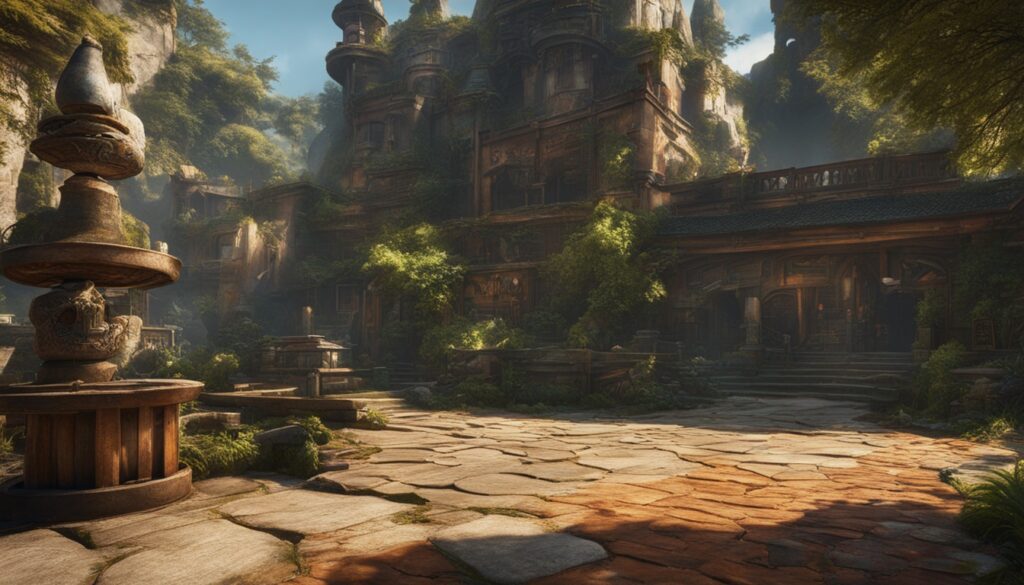Entering the universe of digital games is to be involved in a deep immersion. We feel like we are part of a digitally created world. This immersion means achieving a crucial goal of the gaming industry. The textures and visual details are the key elements of this bridge. They connect the real to the virtual, integrating players into this fictional reality in every detail.
In this text, we will discuss the importance of textures and visual details for the creation of realistic gamesWe will see how these aspects are vital in generating an immersive gaming experience. We will define what makes a game realistic, show prominent examples and understand how details and digital artistic quality influence the player experience.
Main Conclusions
- The textures and visual details are fundamental for the creation of realistic games, providing an immersive and engaging gaming experience.
- THE definition of realistic games involves elements such as graphic fidelity, attention to detail and the search for visual authenticity.
- Notable examples of realistic games include titles such as Red Dead Redemption 2, The Witcher 3 and Horizon Zero Dawn, which stand out for the quality of their digital art.
- Realistic lighting, particle effects and visual post-processing are some of the essential visual details for player immersion.
- Realistic games that focus on visual details and textures tend to provide a more immersive and satisfying gaming experience for players.
What Are Realistic Games?
Realistic games immerse the player in a fictional world that resembles the real one. With high-quality graphics, physics, and environmental details that are close to nature, they become almost real.
Definition and Examples of Realistic Games
Realistic games are those that value truthfulness and precision in details. They provide players with unparalleled feelings of immersion and authenticity. Here are some illustrious examples:
- Red Dead Redemption 2, which transports you to the Wild West with perfection, full of natural beauty and believable human interactions.
- The Last of Us Part II, famous for its complex plots, expressive movements and a captivating post-apocalyptic world.
- Horizon Zero Dawn, mixes fiction with lush nature, creating a unique setting with impressive machines.
These titles underline the relevance of textures and visual details. They make it possible to create deep and intriguing environments that captivate players.
“Realistic games are those that seek to portray the real world in an authentic and immersive way, with high-quality graphics, realistic physics and convincing animations.”
The Importance of Textures in Realistic Games
Textures play an essential role in creating games with vivid realism. They define how objects and environments look, which is crucial to the feeling of reality. This immerses the player in a world where every detail is noticeable.
To achieve a deep visual experience, precise details in textures are necessary. textures in realistic games communicate vital information. They reveal the essence of elements in the game world, such as their structure and properties.
Well-crafted textures provide a more detailed perspective of the game's environment. This improves the perception of key elements such as depth, lighting and shadows. Thus, importance of textures in games is undeniable, increasing both the graphic quality and the impression of realism.
These aspects make textures crucial to increasing player immersion. They connect the player to the game universe, making the experience richer and more engaging. This draws the player into the story and interactions, creating an immersive environment.
Ultimately, textures are key to building realistic games. They not only define the aesthetics, but also drive immersion, contributing to an authentic and captivating experience for players.

"To the textures in games Realistic images are crucial to creating a sense of authenticity and immersion. They define the look and quality of the elements, elevating the player’s visual experience.”
Essential Visual Details for Realistic Games
To achieve maximum verisimilitude, developers need to carefully consider every visual aspect of a game. Among the most critical aspects are: realistic lighting and shadows and the particle effects and post-processing.
Realistic Lighting and Shadows
The way light hits game environments makes all the difference. It not only illuminates, but also gives shape and depth to virtual scenarios. realistic lighting and shadows are fundamental to this process, creating an authentic and immersive atmosphere.
Using advanced techniques, it is possible to accurately simulate how light behaves in real life. This means that shadows are soft, reflections are natural, and indirect lighting makes everything more believable. This results in immersive visual environments that are almost real to the player.
Particle Effects and Post-Processing
Visual details are key to player immersion. particle effects (like smoke, rain), besides the post-processing (bloom, depth of field), add layers of realism. Thus, players are completely absorbed by this experience.
Post-processing effects result in superior image quality. They provide smoother transitions and can even improve the visual clarity of the game. When well combined, these elements create virtual worlds that are surprisingly realistic.
“Attention to the smallest visual details is essential to creating truly realistic and immersive games.”
Realistic Games and Player Immersion
The use of realistic textures and details in games is key to immersion. When done properly, these aspects make the player's experience more fascinating. This makes it easier to feel like you're actually inside the virtual environment.
Details such as accurate lighting, particle effects, and the use of post-processing are crucial. They create a sense of presence that intensifies the relationship between the player and the environment. This technique can generate emotional engagement and increase the perception of realism.
The careful balance of these visual elements is an art. In this way, the developers bring the player closer to realistic virtual worlds. This approach enriches the game, making it an exciting and authentic immersion.
